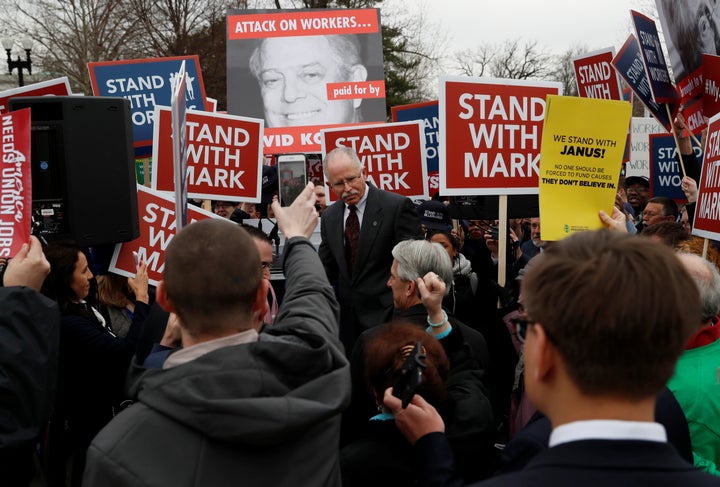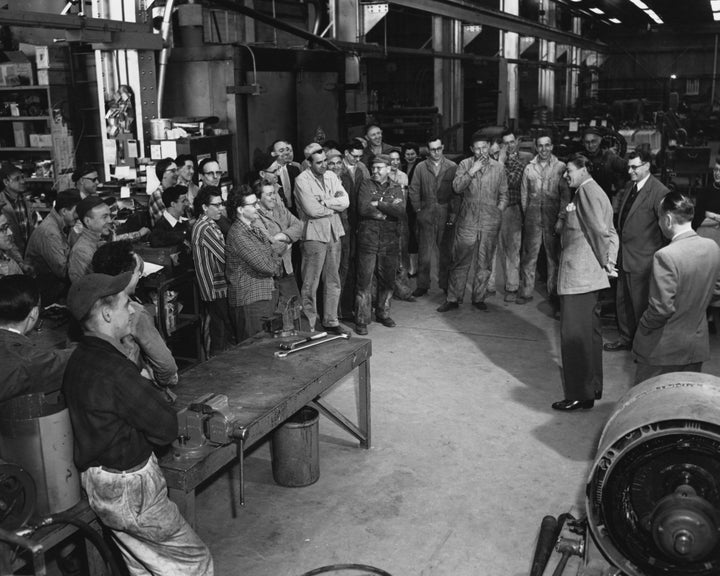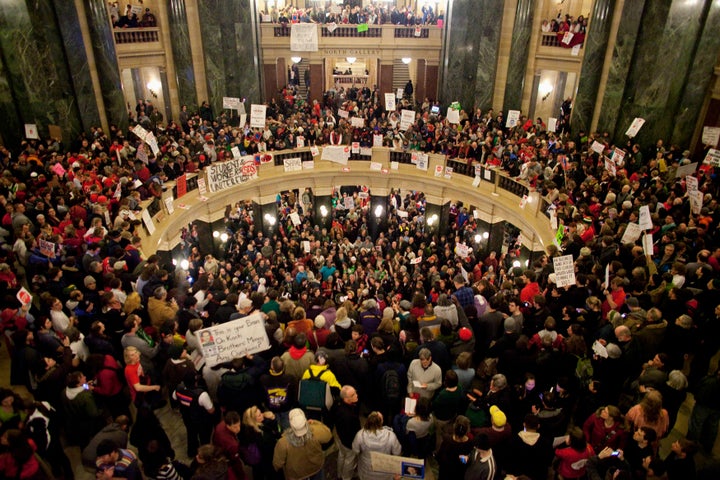
WASHINGTON ― The conservative majority on the Supreme Court looks poised to deliver a historic blow to labor unions after hearing oral arguments in the Janus v. American Federation of State, County and Municipal Employees case on Monday.
An expected 5-4 decision ― with Justice Anthony Kennedy expected to join the court’s more conservative members ― would prevent public sector employee unions across the country from mandating agency fees from members and would be a crowning achievement for a conservative movement founded on opposition to labor.
The only reason this case is before the court now is because Donald Trump, an anti-labor billionaire, won the 2016 presidential election and appointed conservative Justice Neil Gorsuch to replace the deceased Antonin Scalia. The seat was only available because Sen. Mitch McConnell (R-Ky.) refused to hold even a hearing on Merrick Garland, President Barack Obama’s nominee to fill the open seat.
Holding a five-vote majority is the most important priority for the conservative movement, and not just because of evangelicals and Catholics’ desire to repeal Roe v. Wade. The business wing of the conservative movement that dominates the Republican Party has its priorities, too, and crushing labor’s power is item No. 1.
“It’s a culmination of this long struggle that goes way back,” Joseph McCartin, a labor historian at Georgetown University, told HuffPost. He said the Supreme Court oral arguments were “kind of like one of the last skirmishes in what remains in the New Deal order.”
After being roundly driven from power in the Great Depression, the conservative corporate class reorganized for the long haul in opposition to nearly every policy adopted as part of Franklin Roosevelt’s New Deal, from price and wage controls to Social Security to the Tennessee Valley Authority to the Wagner Act, which fully legalized labor unions and established federal oversight of labor-business relations.

The opposition to labor unionism, McCartin said, is based on “a fundamental discomfort with the New Deal itself.”
Among all of these New Deal successes, workers’ empowerment was the most infuriating for wealthy conservatives. Labor unions were their biggest target because they represented organized opposition with significant monetary resources that supported social democratic policies and backed the political opposition to conservative business interests. As Walter Reuther, head of the United Auto Workers, once said, “The labor movement is developing a whole new middle class.”
The conservative movement saw unions as a force that would promote increased government spending and further workers’ empowerment in relation to management.
When pro-business Republicans briefly won control of Congress after World War II, they passed the Taft-Hartley Act to rein in labor union power over President Harry Truman’s veto. The bill banned direct labor union contributions to political parties and candidates, banned closed shops and allowed states to pass so-called “right-to-work” laws.
Right-to-work laws ban unions from mandating the collection of agency fees, which cover the cost of collective bargaining and dispute resolutions. Without a mandate to pay these fees, employees can, and do, choose not to pay them while still receiving the benefits of union protection. Under these rules, unions are almost always short on cash and at a significant disadvantage to protect workers in contract negotiations and disputes.
Barry Goldwater, often referred to as the ideological godfather of the modern Republican Party, got into politics in 1946 as a member of the business elite in Arizona to push for a right-to-work law. He would go on to begin the conservative movement’s takeover of the Republican Party by securing the party’s 1964 presidential nomination.
“Throughout the 1950s and 1960s, the main focus of the anti-union movement was the passage of right-to-work laws.”
After Taft-Hartley’s passage, right-to-work legislation swept through western states and the South, where the idea of labor unions exacerbated segregationist fears of black and white workers working and organizing together. Throughout the 1950s and 1960s, the main focus of the anti-union movement was the passage of right-to-work laws.
At the same time, the movement’s wealthy corporate funders built up their intellectual infrastructure. They promoted the free market ideas of Ludwig von Mises, Friedrich Hayek and Ayn Rand and pushed anti-labor messages that labeled unions as everything from proto-communist operations to autocratic monopolists.
During the 1950s, General Electric emerged as the major corporate force fighting labor unions and boosting the conservative business movement. The company hired Lemuel Boulware as vice president to oversee labor relations and lead the fight against labor. In 1945, Boulware explained in a memo, “Management is in a sales campaign to determine if business and the country will be run right.”
Boulware told the Phoenix Chamber of Commerce that crushing labor was the business community’s “biggest job.” And management needed to defeat unions through marketing to workers and politics, not through brute force of arms, as it had done prior to the New Deal.
Boulware hired actor Ronald Reagan, the former New Deal liberal turned free market true believer, to proselytize the pro-business agenda to GE workers. This was a successful move in both changing workers’ minds on unionizing and cultivating the future of free-market politicians. Reagan’s 1980 presidential victory was the crowning achievement of the conservative movement at the time and marked the beginning of the end of New Deal politics.

The conservative movement’s particular focus on public sector unions did not emerge until the early 1970s. This is largely because Wisconsin’s first-in-the-nation adoption of public sector collective bargaining in 1959 spread across the country, especially after President John F. Kennedy issued an executive order in 1962 providing limited collective bargaining rights to federal workers.
McCartin points to the work of the anti-union activist Sylvester Petro, whom McCartin wrote about in The American Prospect, as pivotal in raising the issue of public sector unions for the conservative movement. Petro was inspired by the writings of Hayek and von Mises and was a member of their Mont Pelerin Society, which had been funded by the same forces that emerged from the post-New Deal conservative movement. In 1957, Petro wrote his first call for the full repeal of the Wagner Act and the end to all collective bargaining.
“It’s right to see the emergence of the opposition to the public sector movement as one that was born at first being opposed to the New Deal itself,” McCartin said. “Being opposed to the very idea of collective bargaining.”
By 1973, Petro was arguing that collective bargaining for public sector workers had destroyed government by putting labor unions on the same level as elected and appointed government officials in making decisions about funding and policy. He argued before the Supreme Court in 1977 in the Abood v. Detroit Board of Education case that public sector employees should not be mandated to pay agency fees.
The court did not agree with him then, but looks poised to overturn that 41 year old decision now.
“It’s right to see the emergence of the opposition to the public sector movement as one that was born at first being opposed to the New Deal itself.”
- Joseph McCartin, Georgetown University
That’s thanks in large part to the corporate elite and managers behind the anti-union conservative movement who, over the ensuing years, built and funded a conservative infrastructure to make the dreams of that small number of post-New Deal free marketeers come true. This included the creation of the American Enterprise Institute, the Heritage Foundation, the State Policy Network and the Federalist Society. The latter counts four Supreme Court justices ― Gorsuch, Chief Justice John Roberts, Samuel Alito and Clarence Thomas ― as members.
The ideological descendants of this movement, including the libertarian billionaire brothers Charles and David Koch, pumped hundreds of millions of dollars into a mix of old and new free-market political organizations after Obama’s 2008 victory. They helped flip state governorships and legislatures across the country to Republicans who supported their long-held desire to crush labor unions.
A wave of attacks on labor unions ensued, with six states adopting right-to-work laws over the next few years. Wisconsin Gov. Scott Walker (R) and a newly elected Republican-controlled legislature immediately repealed the state’s historic public sector collective bargaining law in 2011. In 2015, Wisconsin would pass a right-to-work law. Michigan and West Virginia, both states important in the history of the American labor movement, also adopted right-to-work legislation. This was the most rapid adoption of right-to-work laws since the 1940s and 1950s.

Gutting labor union power was never just about establishing management power in the workplace, but also about gutting labor unions’ political power. Union members have long been able to opt out of making political contributions to union political action committees. But, as anti-labor activists pointed out back in the 1940s, unions also derive power from their ability to fund efforts to advocate for policies on behalf of their workers and keep workers connected to politics in their communities.
This translates to the ballot box, particularly in presidential elections where only the Democratic Party is staunchly pro-union. A recent study from the National Bureau of Economic Research found that the share of the vote for Democratic Party presidential candidates dropped by 3.5 percentage points in states that passed right-to-work laws. Voters also turned out at a lower rate in right-to-work states, which also hurt candidates, largely Democrats, who support labor unions.
This all led to Monday’s court case, and a decision that could gut public employee unions. The conservative justices who spoke during Monday’s oral arguments, and who did not include Gorsuch or Thomas, were openly hostile to the idea of mandatory union agency fees for public employee unions.
Kennedy asked the representative of the state of Illinois arguing in favor of mandatory agency fees whether public employee unions will work with state governments to advocate for “a greater size workforce, against privatization, against merit promotion, against ― for teacher tenure, for higher wages, for massive government, for increasing bonded indebtedness, for increasing taxes.”
The big difference between Kennedy’s argument and the arguments his intellectual ancestors made back in the 1940s is that his will win. The conservative movement will have scored a huge victory in its fight to smash labor’s power.
While voters may not have realized it at the time, this is exactly what was on the line when Trump won on Nov. 8, 2016.
